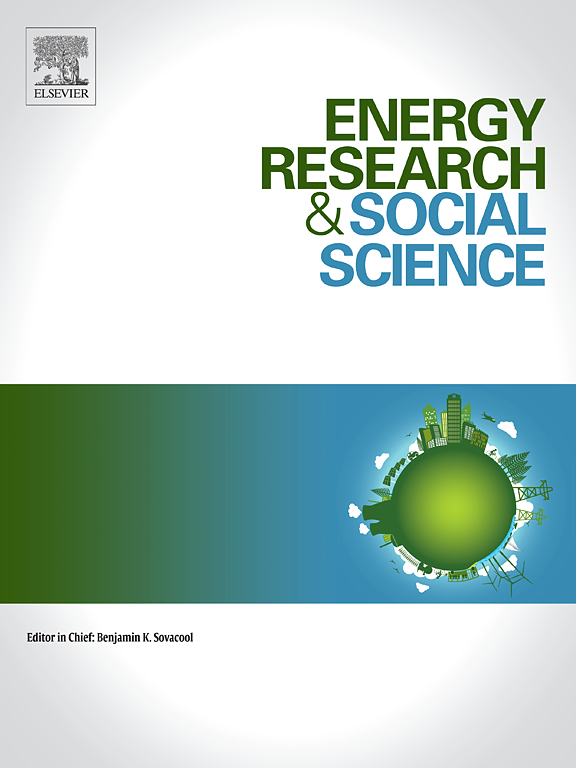Growing gas on the farm? Stakeholder perspectives on divergent models of biogas production in the United States
IF 7.4
2区 经济学
Q1 ENVIRONMENTAL STUDIES
引用次数: 0
Abstract
The agricultural sector has shown increasing interest in on-farm anaerobic digestion (OFAD) systems that convert livestock manure into biogas and digestate co-products. This study examined a potential OFAD supply chain that would use perennial crops, double crops, and other soil-building crops as the primary feedstocks (in addition to or instead of manure) for biogas production. More widespread use of such OFAD systems could enhance soil and water conservation, the economic vitality of rural communities, and climate change adaptation and mitigation, but could also potentially have unintended negative social, economic, and environmental consequences. This research investigated stakeholder synergies and conflicts regarding OFAD technology to inform its development trajectory and promote more sustainable outcomes. To better understand stakeholder perspectives, the research team conducted 36 in-depth interviews with 53 representatives from state- and national-level organizations associated with OFAD, using a theoretical framework combining multi-level sustainability transitions and technology legitimacy perspectives to guide data analysis. The analysis of stakeholder perspectives identified techno-economic, political and institutional, and social and cognitive mechanisms that contribute to the lock-in of large, manure-based digesters while keeping alternative OFAD arrangements in niche-level development stages. Additionally, areas of alignment and misalignment between stakeholder organizations were identified that potentially impact the legitimacy and growth of these innovative technologies. Findings from this research offer insights for policymakers and other stakeholders on how to understand the successes of dominant technologies, such as manure-only OFAD, to foster the growth and uptake of innovative niche technologies, such as herbaceous OFAD, that could provide additional sustainability benefits.
在农场种植天然气?利益相关者对美国不同沼气生产模式的看法
农业部门对农场厌氧消化(OFAD)系统表现出越来越大的兴趣,该系统将牲畜粪便转化为沼气和消化副产品。本研究考察了一个潜在的OFAD供应链,该供应链将使用多年生作物、双季生作物和其他造土作物作为沼气生产的主要原料(除了或代替粪肥)。更广泛地使用这种OFAD系统可以加强水土保持、农村社区的经济活力以及适应和减缓气候变化,但也可能产生意想不到的负面社会、经济和环境后果。本研究探讨了OFAD技术的利益相关者协同效应和冲突,为OFAD技术的发展轨迹提供信息,促进更可持续的成果。为了更好地理解利益相关者的观点,研究团队对与OFAD相关的州和国家级组织的53名代表进行了36次深度访谈,使用了结合多层次可持续性转变和技术合法性视角的理论框架来指导数据分析。对利益相关者观点的分析确定了技术经济、政治和制度以及社会和认知机制,这些机制有助于锁定大型粪便消化池,同时将其他OFAD安排保持在利基水平的发展阶段。此外,确定了利益相关者组织之间的一致和不一致的领域,这些领域可能会影响这些创新技术的合法性和增长。这项研究的结果为政策制定者和其他利益相关者提供了见解,帮助他们了解如何理解主导技术(如纯粪肥OFAD)的成功,以促进创新利基技术(如草本OFAD)的增长和吸收,从而提供额外的可持续性效益。
本文章由计算机程序翻译,如有差异,请以英文原文为准。
求助全文
约1分钟内获得全文
求助全文
来源期刊

Energy Research & Social Science
ENVIRONMENTAL STUDIES-
CiteScore
14.00
自引率
16.40%
发文量
441
审稿时长
55 days
期刊介绍:
Energy Research & Social Science (ERSS) is a peer-reviewed international journal that publishes original research and review articles examining the relationship between energy systems and society. ERSS covers a range of topics revolving around the intersection of energy technologies, fuels, and resources on one side and social processes and influences - including communities of energy users, people affected by energy production, social institutions, customs, traditions, behaviors, and policies - on the other. Put another way, ERSS investigates the social system surrounding energy technology and hardware. ERSS is relevant for energy practitioners, researchers interested in the social aspects of energy production or use, and policymakers.
Energy Research & Social Science (ERSS) provides an interdisciplinary forum to discuss how social and technical issues related to energy production and consumption interact. Energy production, distribution, and consumption all have both technical and human components, and the latter involves the human causes and consequences of energy-related activities and processes as well as social structures that shape how people interact with energy systems. Energy analysis, therefore, needs to look beyond the dimensions of technology and economics to include these social and human elements.
 求助内容:
求助内容: 应助结果提醒方式:
应助结果提醒方式:


